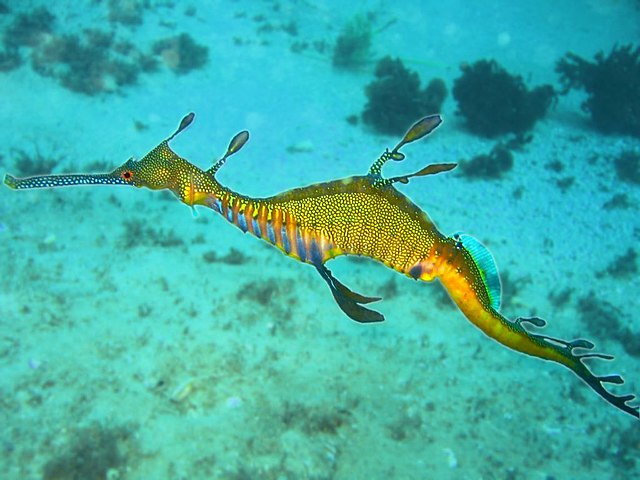species of fish From Wikipedia, the free encyclopedia
The weedy sea dragon or common sea dragon, Phyllopteryx taeniolatus, is a marine fish related to the seahorse. It is the only member of the genus Phyllopteryx. It is found in water 3 to 50 m deep around the south coast of Australia, from Port Stephens, New South Wales to Geraldton, Western Australia. It also found in the waters around Tasmania. Weedy sea dragons are named for the weed-like growth on their bodies. This camouflage hides them as they move among the seaweed beds where they live. The weedy sea dragon is the aquatic emblem for the state of Victoria.[1]
| Weedy sea dragon | |
|---|---|
 | |
| Picture by Ferdinand Bauer | |
| Scientific classification | |
| Kingdom: | |
| Phylum: | |
| Class: | |
| Order: | Syngnathiformes |
| Family: | Syngnathidae |
| Genus: | Phyllopteryx Swainson, 1839 |
| Binomial name | |
| Phyllopteryx taeniolatus (Lacepède, 1804) | |
 | |
| Where weedy sea dragons are found. | |

Weedy sea dragons can reach 45 cm in length. They feed on tiny crustaceans and other zooplankton, which they suck into the end of their long tube-like nose. Their tail cannot wrap around and hold on to things the way a seahorse can. They swim in shallow reefs and weed beds, and look like weeds drifting over bare sand.[2]
Sea dragons, seahorses and pipe fish are the only species where the male carries the eggs. The male carries the fertilized eggs, joined under his tail. They stay there for about eight weeks until they hatch. The young can look after themselves as soon as they are born.[2] Breeding sea dragons in captivity is difficult because scientists do not know what makes them breed in the wild. To make them breed, carers in the Melbourne Aquarium had to change the water temperature and lighting to copy the places where wild weedy sea dragons live.[3]
The Aquarium of the Pacific in Long Beach, California, Melbourne Aquarium in Australia, and the Tennessee Aquarium in Chattanooga, Tennessee,[4] are the only places in the world to have bred weedy sea dragons, though others have been able to get them to lay eggs.[5]
A relative of the weedy sea dragon is the leafy sea dragon Phycodurus eques. In the November 2006, the National Geographic magazine, reported that marine biologist Greg Rouse is looking at the DNA of the two sea dragon species.
Seamless Wikipedia browsing. On steroids.
Every time you click a link to Wikipedia, Wiktionary or Wikiquote in your browser's search results, it will show the modern Wikiwand interface.
Wikiwand extension is a five stars, simple, with minimum permission required to keep your browsing private, safe and transparent.